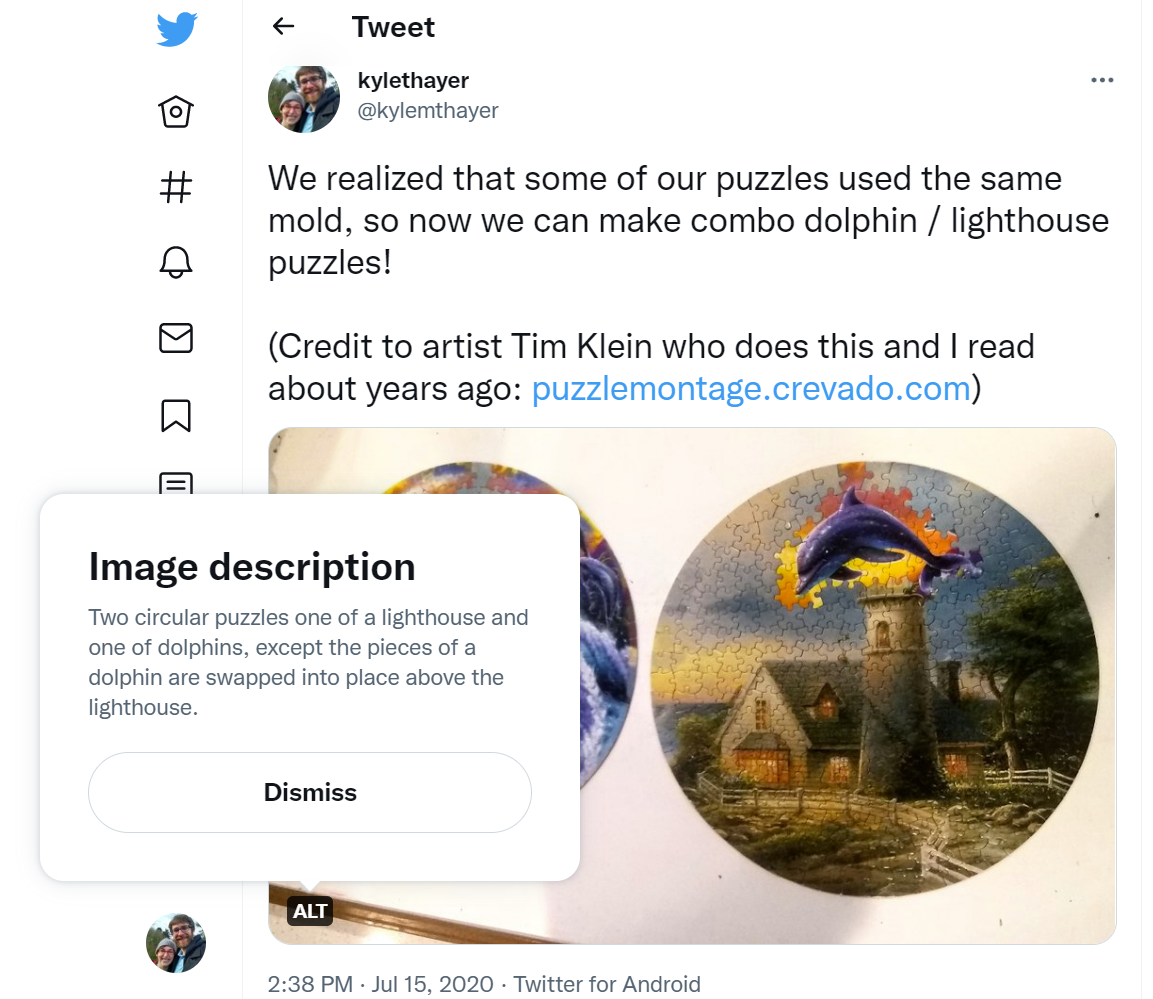Tying It Together
2.4. Tying It Together#
Now that we have defined social media, ethics, and programming, we will spend the rest of this book tying them together in different ways.
To give one example, let’s look at the experience of people who use social media but can’t view images (they may be blind or low vision, or their device or internet might have restrictions). In order to make the information from the image accessible to these users, social media platforms allow images to be posted with an “alt text”, which the user can read (or have the computer read to them). See Fig. 2.2 below for an example.

Fig. 2.2 A tweet with a photo that has an “alt text” (seen in the popup over the image), so those who cannot see the photo still have access to the information in the tweet.#
Now, people who design and program social media platforms can do things to encourage or discourage users adding alt-text to their photos. For example, they could require or forbid users from adding alt-text to their photos, or they could do more subtle versions of those by putting reminders to add alt-text, or making the option of adding alt-text hard to find. Additionally, they could run a machine learning program to try to automatically generate alt-text for photos, though those programs may make mistakes or have biases.
So what are the ethical questions facing the designers and programmers of social media platforms? Are they responsible for designing their platforms around this accessibility issue, or is it the responsibility of users uploading image data to make their content accessible by using alt-text?
Imagine a debate on this question between someone using the Aztec Virtue Ethics framework, and someone using the Natural Rights framework.
Have a think about your answers, and then click to see some sample answers
Natural Rights (all humans have rights that should not be violated):
Every individual has the right to post how they see fit, for whichever audiences they choose. If they do not want to include alt-text (perhaps because they do not consider anyone who can’t view images to be part of their community or audience), then that is their prerogative.
OR
Every individual has a right to the information posted on social media, even if they can’t view images. So not including alt-text is a violation of their rights and platforms should force users to include alt-text.
Aztec Virtue Ethics (virtue is a group effort and we all need support to find balance and moderation):
It is everyone’s responsibility to support others, so the platform should make everyone support those who can’t view images by forcing them to include alt-text.
OR
Everyone should be supported in finding balance and moderation, and so a platform shouldn’t force users to include alt-text even when it doesn’t make sense or is unnecessarily burdensome (that wouldn’t be moderation).
Now imagine we propose letting the platforms wait and add the ability to include alt-text when users are really ready for it. How might a Taoist and a Consequentialist respond?
Have a think about your answers, and then click to see some sample answers
Taoist:
Trying to force this issue will likely backfire. Just leave things as they are, until the users are themselves asking for this option to be integrated into the platform’s design.
OR
You should make adding alt-text part of the natural flow of posting images.
Consequentialist:
There are actually very few people who can’t view images, so having people do extra work for those very few people is a waste of time.
OR
The difficulty caused to people who can’t view images when there is no alt-text is very significant, so a minor burden of having users add alt-text is worth the trade-off.
Now look back through how those frameworks framed the issues. Remember, each framework is a tool to help us see inside the problem. What does each tool show us? What do you learn from comparing the different approaches?
Note
While we show how these frameworks might argue for different approaches to image alt-text, we don’t want to give the impression that we are neutral about an issue like alt-text. Please provide alt-texts for images and encourage others to do the same! We will talk more about accessibility in chapter 10.
This is a small example of the kind of reflection that we will be returning to again and again throughout the course. As we get more deeply acquainted with the automation side of things, we will be able to use these ethical tools to look deeper into questions of Social Media, Ethics, and Automation.
